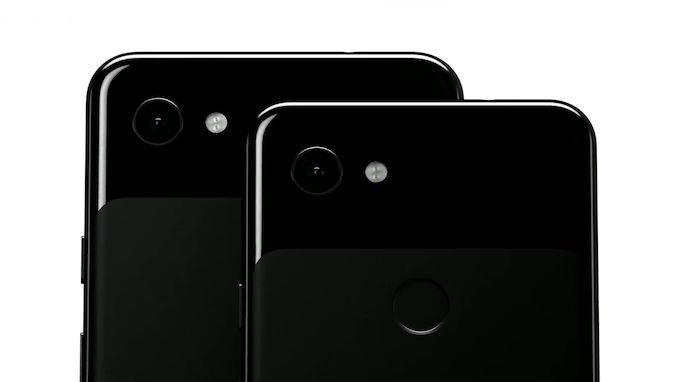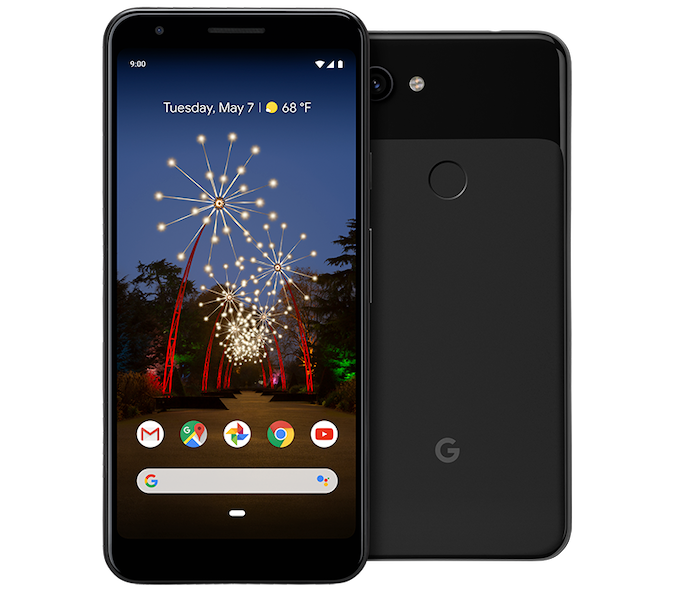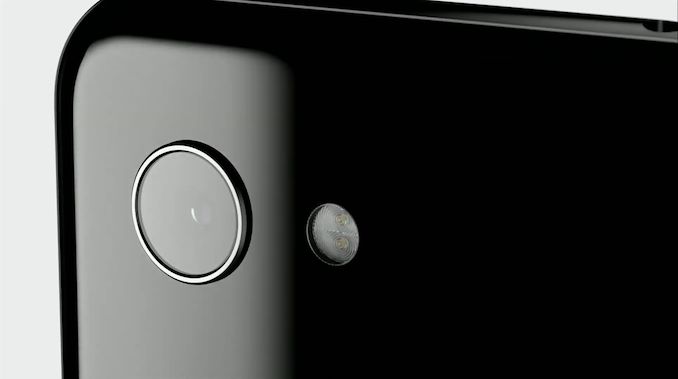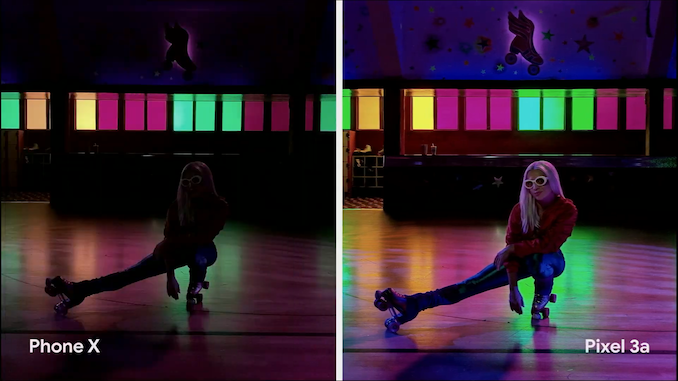Google Announces Pixel 3a & Pixel 3a XL: Mid-Range Phones With Flagship Camera
by Andrei Frumusanu on May 7, 2019 2:30 PM EST- Posted in
- Mobile
- Smartphones
- Pixel 3a
- Pixel 3a XL

Google’s Pixel smartphone line-up has been a mainstay of the industry for a few years now. We’re all familiar with devices such as the latest Pixel 3 which is Google’s latest entry in the high-end flagship market. In particular Google puts a lot of emphasis on the cameras of the Pixel devices, and last year in particular, Google, along with Huawei, have raised the bar in terms of what is possible to achieve thanks to computational photography.
While the Pixel devices definitely have their strengths, one inarguable competitive weakness of the phones is their pricing. At an official MSRP and current Google store price of $799 for the Pixel 3 and $899 for the 3 XL, Google demands quite a lot, especially in view of other newer possibly more attractive options from the competition.
In an attempt to widen its product range and adhere to a more price-sensitive audience, today we see the introduction of the new Pixel 3a and Pixel 3a XL. The two new phones are very much placed at more mid-range price-points, yet without compromising much on what Google sees as the keystone of the Pixel phones: the camera.
Going over the specifications of the two new phones:
| Google Pixel 3a's | ||||
| Pixel 3a | Pixel 3a XL | |||
| SoC | Snapdragon 670 2x Kryo 360 (CA75) @ 2.0GHz 6x Kryo 360 (CA55) @ 1.7GHz Adreno 615 |
|||
| DRAM | 4GB LPDDR4X | |||
| Display | 5.6" OLED 2220 x 1080 (18:9) |
6.0" OLED 2220 x 1080 (18:9) |
||
| Size | Height | 151.3 mm | 160.1 mm | |
| Width | 70.1 mm | 76.1 mm | ||
| Depth | 8.2 mm | 8.2 mm | ||
| Weight | 147 grams | 167 grams | ||
| Battery Capacity | 3000mAh | 3700mAh | ||
| Wireless Charging | - | |||
| Rear Cameras | ||||
| Main | 12.2MP 1.4µm Dual Pixel PDAF f/1.8 76° lens with OIS |
|||
| Telephoto | - | |||
| Wide | - | |||
| Extra | - | |||
| Front Camera | 8MP 1.12µm f/2.2 84° lens; fixed focus |
|||
| Storage | 64GB eMMC | |||
| I/O | USB-C 3.5mm headphone jack |
|||
| Wireless (local) | 802.11ac Wave 2 Wi-Fi Bluetooth 5.0 LE + NFC |
|||
| Cellular | UE Category 11 (DL) / Category 5 (UL) 600Mbit/s DL (3xCA 2x2 MIMO) 75Mbit/s UL |
|||
| Other Features | Dual Speakers, 18W Fast Charging | |||
| Dual-SIM | 1x nanoSIM | |||
| Launch Price | $399 / £399 / €399 | $479 / £469 / €479 | ||
At the heart of both phones we find a new Snapdragon 670 SoC from Qualcomm. The chip was announced last August and comes with a 2+6 CPU core configuration consisting of 2 Cortex A75 cores at 2GHz and 6 Cortex A55 cores at 1.7GHz, accompanied by an Adreno 615 GPU. The chip is manufactured on Samsung’s 10LPP process node.
It’s actually quite odd to see Google go with the Snapdragon 670, given that Qualcomm offers a slew of other newer options such as the Snapdragon 675. Here it’s possible that the Pixel 3a phones just come at an odd timing between generations and weren’t able to employ the newer SoC.
Google fits the Pixel 3a’s with 4GB of LPDDR4X, which is a fair for mid-range devices. In terms of storage, the devices comes with a single 64GB option, without expandable storage. Don't expect the phones' storage performance to be especially high either, as Google is using legacy eMMC here instead of UFS.
Design-wise, both phones looks night identical to the smaller Pixel 3, using the same design language and characteristic features. It’s interesting that for the bigger Pixel 3a XL, Google also opted to use the notch-less design, avoiding this much critiqued aspect of the Pixel 3 XL.
Both phones continue to employ OLED panels. The smaller Pixel 3a comes with a 5.6” 18:9 screen with a resolution of 2220 x 1080. The larger 3a XL has a 6.0” screen with the same resolution.
Instead of using a glass back like on the Pixel 3 series, the new Pixel 3a’s come with unibody polycarbonate designs. On one hand, this reduces the weight of the phones, with the Pixel 3a coming in at 147g and the XL at 167g, but also should result in a more scratch prone phone.
Battery capacity for the smaller 3a is 3000mAh while the XL gets a notably larger 3700mAh battery. The phone supports 18W charging, however one of the axed features looks to be wireless charging as the new phone are lacking it.
Even though Google removed the port 2 years ago in the Pixel 2, the new Pixel 3a sees the return of the 3.5mm headphone jack. We live in quite the weird world today where vendors decide that removing a feature on the more premium models is something the consumers should want, but at least it’s all good for the Pixel 3a’s.
Google continues to employ dual front facing speakers with stereo playback capability.
An important aspect of the Pixel 3a’s is their cameras: Inherently, the single rear module is exactly the same as found on the Pixel 3, meaning the Pixel 3a should have the same imagining capability as its higher end sibling. The 12.2MP sensor has 1.4µm pixel pitches and employs full sensor dual pixel PDAF, with the optics being an f/1.8 lens with a 76° viewing angle and keeps the OIS mechanism – something that is quite rare in mid-range devices.
One thing that isn’t clear is if the Pixel 3a’s employ Google Visual Core. Inherently there shouldn’t be need for it for the mid-range phone to have the same photography features as its higher end sibling as computation can be picked up by the Snapdragon’s DSP cores – although they might be slower at the task. Indeed Google continues to promise the same key features as on the high-end model, including Night Sight and Portrait Mode.
The Pixel 3a comes in “Just Black”, “Clearly White” and “Purple-ish” for $399, while the Pixel 3a XL comes in at $479. In the US, the device will premier not only on Verizon, but also T-Mobile, Sprint and US Cellular, alongside the Google Store in various other countries.













72 Comments
View All Comments
peevee - Wednesday, May 8, 2019 - link
9 mm is too much and does not help it to fit into pockets, and weight.$400 for 2xA7 in 2019 is just poor. So is eMMC. It is not Nexus, the line which was as cheap but always included top of the line internals. The SOC also includes weaker ISP, isn't it?
notashill - Wednesday, May 8, 2019 - link
Weight is lower than the S10e though, 147g vs 150g.porcupineLTD - Wednesday, May 8, 2019 - link
Diagonals stopped having meaning when the aspect ratio changed.amosbatto - Sunday, May 12, 2019 - link
Bezels are designed to protect the screen if the phone is dropped. Getting rid of bezels is an insane idea. I wish that every reviewer who waxes eloquent about the new bezelless wonders would be forced to do a review of the phone after the screen was cracked. Then, they should be forced to follow the instructions at iFixit to try and fix the cracked screen. Now that would be a phone review that I am willing to read.eastcoast_pete - Wednesday, May 8, 2019 - link
Wait until you see their coal-burning steam-powered model - that's the one to get!Marlin1975 - Tuesday, May 7, 2019 - link
"odd to see Google go with the Snapdragon 670, given that Qualcomm offers a slew of other newer options such as the Snapdragon 675"No its not. The 670 has a faster GPU and made on a small NM process. The difference between the 75 and 76 is not that large enough for most to notice, but a slower GPU and more power draw/shorter battery life will be. Let alone the 670 may be cheaper.
levizx - Tuesday, May 7, 2019 - link
You are hanging up on the wrong thing. 675 *is* newer, and on top of that, there's also 730 which is better in every way - both are part of "other newer options".Dug - Tuesday, May 7, 2019 - link
I find it odd that they keep spending time and energy producing chips so close to each other.ZolaIII - Wednesday, May 8, 2019 - link
They all (S67x, S7xx) have same GPU just differently clocked. Difference between lithography is neglect able (14 nm UHD and 10 nm second gen). Google whose slow in development process, the phone is to much retro and overpriced...peevee - Wednesday, May 8, 2019 - link
"The difference between the 75 and 76 is not that large"Actually it is huge, especially given that there are only 2 of them.